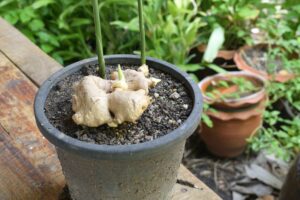How to Grow Ginger in Containers

Unlocking the Secrets of Growing Ginger
Ginger is one of the most widely cultivated and used crops in the world, with a rich history dating back thousands of years. Originating in Southeast Asia, this versatile plant has become a staple ingredient in cuisines around the globe, prized for its distinctive flavor, aroma, and numerous health benefits. In this comprehensive guide, we’ll dive into the secrets of growing ginger in containers, unlocking the keys to achieving an epic ginger harvest right in your own backyard.
Understanding the Ginger Plant
Before we begin our ginger-growing journey, it’s important to understand the true nature of this remarkable plant. Contrary to popular belief, what we commonly refer to as the “ginger root” is actually the rhizome, a modified underground stem that serves as the plant’s primary storage and reproductive structure. This rhizome is the part we harvest and use in a myriad of culinary and medicinal applications.
Choosing the Right Ginger Rhizome
When selecting ginger rhizomes to plant, look for those with visible “eyes” or growth buds. These are the points from which the new shoots will emerge, and the larger the rhizome, the more shoots it will produce. This translates to a faster-growing plant and a more bountiful harvest. When purchasing ginger at the grocery store, be on the lookout for these telltale signs of viability.
Preparing the Ginger Rhizome for Planting
Once you’ve acquired your ginger rhizome, you have the option to pre-sprout it before planting. This can be done by placing the rhizome in a bowl of water and allowing it to sit until you see the first signs of root and shoot development. Alternatively, you can skip this step and plant the rhizome directly into your container. Either way, the rhizome will begin to sprout and grow in the soil.
Choosing the Right Container
When it comes to growing ginger in containers, the key is to select a wide, shallow pot rather than a narrow, deep one. This is because the rhizome grows horizontally, expanding outward as the plant matures. A wide, shallow container will provide ample room for the rhizome to spread and thrive.
Preparing the Soil
Ginger thrives in a rich, well-draining potting mix that is high in organic matter. Avoid dense, heavy soils, as the rhizome needs room to spread and expand. A high-quality potting mix is an excellent choice. Be sure to lightly cover the rhizome with soil, leaving just a small portion exposed.
Planting and Watering
When planting the ginger rhizome, gently press it into the soil and water it in. However, don’t over water at this stage, as the plant has not yet developed a robust root system. Aim to keep the soil moist but not waterlogged. As the plant begins to sprout and grow, you can gradually increase the watering frequency to meet its needs.
Ideal Growing Conditions
Ginger is a tropical plant, thriving in warm, humid environments with ample rainfall. When growing ginger in containers, it’s best to start the plants indoors in the spring, especially if you live in a climate with harsh winters. Once the sprouts emerge, you can gradually transition the plants to an outdoor location, ensuring they receive plenty of sunlight and protection from frost.
Troubleshooting Common Issues
As with any plant, there are a few potential issues you may encounter when growing ginger in containers. Here are some common problems and how to address them:
- Browning or yellowing leaves: This could be a sign of insufficient moisture or nutrient deficiency. Try increasing watering frequency or applying a balanced, organic fertilizer.
- Soggy, rotting rhizomes: Over watering is the culprit here. Ensure your container has adequate drainage and adjust your watering schedule accordingly.
- Flowering: Don’t worry if your ginger plant flowers – this is a natural part of its life cycle. You can still harvest the rhizomes, and the flowers are even edible!
If you encounter any other issues, be sure to consult the comments section below or reach out to the Epic Gardening team for personalized advice.
Harvesting and Storing Ginger
Depending on your climate and growing conditions, you can typically harvest your ginger rhizomes 4-5 months after planting. If you’re in an area where the plant will die back during the winter, it’s best to harvest the entire crop before the first frost. However, if you can overwinter your ginger, you can selectively harvest new rhizome sections while allowing the plant to continue growing.
After harvesting, thoroughly clean the rhizomes and store them in a cool, dark place, such as a root cellar or refrigerator. This will allow you to replant the ginger in the spring for a continuous supply of this versatile crop.
Turning Ginger into Powder
One of the best ways to preserve and utilize your homegrown ginger is by turning it into a versatile powder. This process is simple and straightforward, and the resulting ginger powder can be used in a wide range of culinary and medicinal applications.
To make ginger powder, start by thoroughly washing and slicing the rhizomes into uniform pieces. Dehydrate the slices in a food dehydrator or oven, ensuring they become crisp and brittle. Once fully dried, use a spice grinder or high-powered blender to transform the dehydrated ginger into a fine powder. Store the ginger powder in an airtight container, and enjoy the convenience of having this flavorful seasoning on hand.
Ginger’s Culinary and Medicinal Uses
Ginger is a true powerhouse, offering a wealth of culinary and medicinal benefits. In the kitchen, ginger can be used fresh, dried, or powdered to add its distinctive flavor to a wide range of dishes, from savory curries and stir-fries to baked goods and teas. The rhizome can also be candied, pickled, or used to make ginger ale and other beverages.
Beyond its culinary applications, ginger has long been revered for its medicinal properties. It is known to possess anti-inflammatory, antioxidant, and digestive-aiding properties, making it a valuable natural remedy for ailments such as nausea, muscle soreness, and respiratory issues. Incorporating homegrown ginger into your daily routine can be a simple and effective way to support your overall health and well-being.
Grow Your Own Ginger for an Epic Harvest
Growing ginger in containers is a rewarding and surprisingly easy endeavor, allowing you to enjoy the fresh, flavorful bounty of this remarkable plant right in your own backyard. By following the tips and techniques outlined in this guide, you’ll be well on your way to cultivating an epic ginger harvest that will elevate your culinary creations and support your overall health.

Frequently Asked Questions
Can I grow ginger indoors year-round?
Yes, you can absolutely grow ginger indoors year-round, provided you give it the right growing conditions. Ginger thrives in warm, humid environments with ample sunlight, so a bright, well-ventilated indoor space can work well. Just be sure to keep the soil consistently moist but not waterlogged.
How long does it take to grow ginger from a rhizome?
Typically, it takes 4-5 months from planting the rhizome to harvesting the mature ginger. However, the exact timeline can vary depending on factors like growing conditions, container size, and the size of the initial rhizome. With the right care, you can often get a decent harvest in as little as 3-4 months.
Can I regrow ginger from store-bought pieces?
Absolutely! The ginger rhizomes you find at the grocery store are perfectly suitable for planting and growing your own ginger at home. Just look for pieces with visible “eyes” or growth buds, and follow the planting instructions outlined in this guide.
How do I know when to harvest my ginger?
As a general rule, you can start harvesting your ginger rhizomes 4-5 months after planting. However, the best time to harvest will depend on your climate and growing conditions. If you’re in an area with harsh winters, it’s best to harvest the entire crop before the first frost. In milder climates, you can selectively harvest new growth while allowing the plant to continue growing.
Can I grow ginger in the same container year after year?
Yes, you can absolutely grow ginger in the same container year after year, provided you give the plant the proper care and attention. After harvesting, simply replant the rhizome sections in fresh, nutrient-rich potting mix, and the ginger will continue to thrive and produce new growth.


